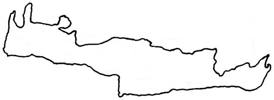
|
The Society of Folk Dance Historians (SFDH) Crete
[
Home |
About |
Encyclopedia | CLICK IMAGE TO ENLARGE |

|
BACKGROUND
Information: An island.
Crete is the largest and most populous of the Greek islands, the 88th largest island in the world and the fifth largest island in the Mediterranean Sea, after Sicily, Sardinia, Cyprus, and Corsica. Crete rests approximately 99 miles south of the Greek mainland.
Humans have inhabited the island since at least 130,000 years ago, during the Paleolithic age. Crete was the center of Europe's first advanced civilization, the Minoans, from 2700 to 1420 BCE.
The island is mostly mountainous, and its character is defined by a high mountain range crossing from west to east. It includes Crete's highest point, Mount Ida, and the range of the White Mountains (Lefka Ori) with 30 summits above 6,500 feet in altitude.
Following the repeated uprisings in 1841, 1858, 1889, 1895, and 1897 by the Cretan people who wanted to join Greece, the Great Powers decided to restore order and in February 1897 sent in troops. The island was subsequently garrisoned by troops from Great Britain, France, Italy, and Russia. With the break out of the First Balkan War, the Greek government declared that Crete was now Greek territory. This was not recognized internationally until December 1, 1913.
During World War II, the island was the scene of the famous Battle of Crete in May 1941. The initial 11-day battle was bloody and left more than 11,000 soldiers and civilians killed or wounded. As a result of the fierce resistance from both Allied forces and civilian Cretan locals, the invasion force suffered heavy casualties, and Adolf Hitler forbade further large-scale paratroop operations for the rest of the war. During the initial and subsequent occupation, German firing squads routinely executed male civilians in reprisal for the death of German soldiers; civilians were rounded up randomly in local villages for the mass killings, such as at the Massacre of Kondomari and the Viannos massacres. Two German generals were later tried and executed for their roles in the killing of 3,000 of the island's inhabitants.
Today, the island's tourism infrastructure caters to all tastes, including a very wide range of accommodation; the island's facilities take in large luxury hotels with their complete facilities, swimming pools, sports and recreation, smaller family-owned apartments, camping facilities, and others.
Regional Dance: Haniotiko Syrto
Location: Greece
Language: Greek
Religion: Orthodox faith
DOCUMENTS
- Cretan Affair, an article.
- Cretan Passion for Dance, a country.
- Greece, a country.
This page © 2018 by Ron Houston.
Please do not copy any part of this page without including this copyright notice.
Please do not copy small portions out of context.
Please do not copy large portions without permission from Ron Houston.